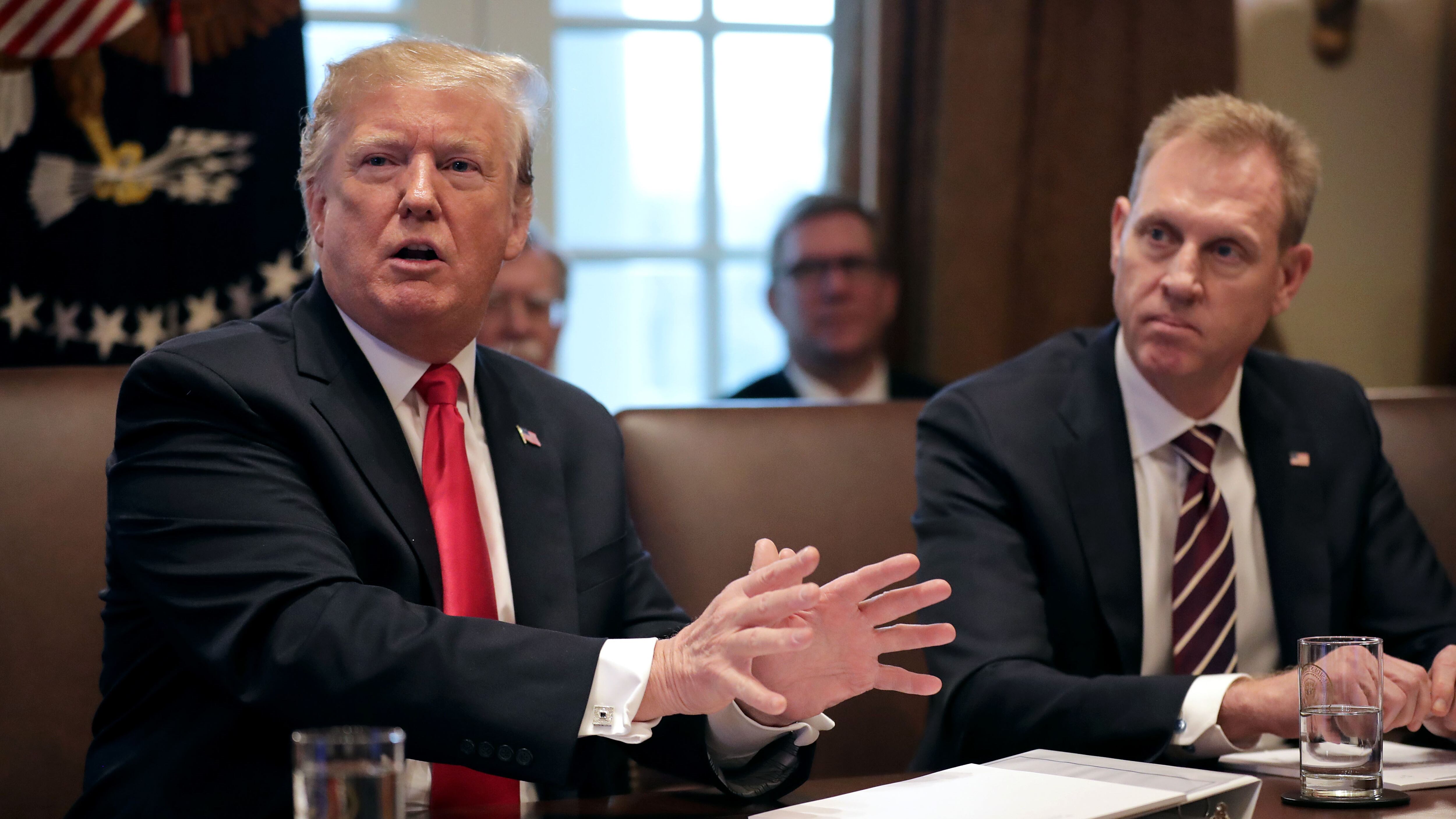WASHINGTON — The U.S. Army’s budget request of $182 billion in fiscal year 2020 holds steady with last year’s top line, but is geared toward a “modernization renaissance” the service began with the 2018 establishment of a new four-star command dedicated to building a modern force by 2028.
In addition to the $182 billion top line, the Pentagon is requesting $9.2 billion in emergency funding, which will be applied entirely to the Army budget, according to Defense Department budget request documents. The funds could be used to cover funding gaps in military construction that result from President Donald Trump’s move to use an emergency declaration for a wall at the United States’ southern border.
As Defense News first reported, the service’s base budget request this year is $151 billion with $31.4 billion of that budgeted as Overseas Contingency Operations-for-base funding.
RELATED

For complete Pentagon budget coverage, click here.
The Army’s end-strength numbers will slow in FY20 due to a bad recruiting year in FY19. While the service planned to grow the active force to 487,500, it closed out FY19 with 478,000 troops. The plan now is to increase the Army end-strength by 2,000 in FY20 and subsequent years, rather than the planned 4,000 per year, a defense official told Defense News ahead of the budget request release.
The Army National Guard will grow by 500 in FY20 to 336,000 and the Army Reserve will grow by 250.
Operations and maintenance
The operations and maintenance (O&M) account would grow by roughly $1 billion in FY20 from $40.8 billion in FY19 to $42 billion in the new request.
The funding is geared to achieving readiness objectives by 2022 by resourcing 25 Brigade Combat Team Combat Training Center rotations, improving BCT home station training, and increasing One Station Unit Training from 14 to 22 weeks for infantry soldiers.
The funding will maintain 58 BCTs, six Security Force Assistance Brigades and 11 Combat Aviation Brigades.
The funding also covers two major multi-lateral exercises in the Pacific and Europe — Defender Europe and and Defender Pacific.
The Army also plans to increase the flying hour program from 10.8 hours to 11.6 hours.
Research and Development
The Army is seeking $12.2 billion in research, development, test and evaluation funding and $21.8 billion in procurement that aligns with the Army’s six modernization priorities: Long-Range Precision Fires, Next Generation Combat Vehicle, Future Vertical Lift, the network, air-and-missile defense and soldier lethality.
In order to fund its priorities, the service is divesting legacy platforms and systems over time. According to service documents, without going into specifics, the Army plans to eliminate 93 programs and delay or reduce 93 programs across the next five budget cycles. That effort will save the service $2.5 billion.
Not much clarity is provided in the Army budget documents in terms of what will be cut and what will be slowed, but according to a defense official, upgrade programs for the CH-47 Chinook cargo helicopter and the Bradley are at greatest risk of reductions in the near term.
The Army is increasing its investment in the top six priorities over the next five years by $32.8 billion from $24.2 billion to $57 billion.
Near-term focus will be placed on 30 systems including the Army’s Strategic Long-Range Cannon, the Future Attack Reconnaissance Aircraft, Mobile Protected Firepower, Unified Network, Indirect Fire Protection Capability, Assured Position, Navigation and Timing equipment, Integrated Visual Augmentation System and the Synthetic Training Environment One World Terrain.
The service plans to spend $387 million to develop its Optionally Manned Fighting Vehicle in FY20 to replace the Bradley. The funding will go toward a contract award for up to two vendors to provide prototypes as part of the program.
RELATED
Replacing the Bradley is the top priority for the Army’s next-gen combat vehicle modernization team
A total of $310 million is requested for the Mobile Protected Firepower program’s competitive prototyping effort.
The Army wants $427 million for its Future Attack Reconnaissance Aircraft that would complete the competitive initial design phase in FY20.
The Lower-Tier Air-and-Missile Defense program would receive $428 million to initiate prototypes of systems.
The Army is requesting $243 million for its Indirect Fire Protection Capability Increment 2 program that will go toward the funding of an interim capability — said to be the Iron Dome system that the U.S. co-developed with Israel.
Procurement
In its RDA procurement account, the service is requesting $21.8 billion, which is a slight increase of last year’s enacted funding of $22.1 billion.
The Army’s is asking for less funding in aviation in FY20 — a total of $3.7 billion — after receiving $4.3 billion in funding in the prior year. The funding is intended to sustain AH-64 Apache attack helicopter and Chinook remanufacture efforts as well as an increase of 15 UH-60 Black Hawk utility helicopters — for a total of 73 — over last year’s buy.
The service plans to spend $3.2 billion in missiles procurement, which is roughly the same amount of funding it received in FY19.
Yet the budget boosts procurement for missiles like Hellfire and Guided Multiple Launch Rocket System rockets. The Army procured 2,309 Hellfire missiles in FY19 and is asking for 5,112 in FY20. The Army wants 9,570 GMLRS rockets in FY20 up from 7,818 in FY19.
The Army is requesting $4.7 billion in its FY20 budget for weapons and tracked combat vehicle procurement, only slightly more than it received last year in the same account.
Procurement funding was increased specifically for the Bradley Fighting Vehicle, Stryker combat vehicle, Abrams tank and Paladin Integrated Management modernization. The service wants to upgrade 128 Bradley vehicles in FY20 and plans to upgrade 152 Strykers, up from 82 vehicles in FY19.
The service cut its procurement of the Joint Light Tactical Vehicle by 863 vehicles. The Army procured 3,393 vehicles in FY19 in low-rate initial production but only plans to buy 2,530 vehicles in FY20.
The Army had planned, in FY19, to buy 3,035 vehicles in FY20, according to last year’s budget request.
The reduction likely accounts for the delay of the JLTV’s full-rate production decision that was pushed from December 2018 to May 2019 due to a number of changes to the vehicle the Army has decided to make as the result of soldier feedback, including a larger back window and the addition of a muffler. The approach is designed to minimize the cost and quantity of the vehicles that would need to be retrofitted, according the vehicle’s program office.
The Army also plans to increase funding for Mobile-Short Range Air Defense systems in order to equip the first four M-SHORAD battalions as planned.
Additionally, the service plans to accelerate procurement of Manpack radios, Ground Soldier Systems and increase funding for the Signal Modernization Program in support of the Integrated Tactical Network.
Reform
The Army also laid out its efforts to reform its business practices, policies and how it aligns funding with needed resources in its budget documents.
The service notes that it saved $277.9 million in FY20 through business improvements such as better contract management and its Command Accountability and Execution Review (CAER) program.
Additionally, the Army saved $177.9 million in FY20 dollars through policy reform associated with realigning its civilian workforce to establish Army Futures Command.
An additional $717.9 million was saved by streamlining and eliminating duplicative efforts in Army Logistical Support Operations.
Jen Judson is an award-winning journalist covering land warfare for Defense News. She has also worked for Politico and Inside Defense. She holds a Master of Science degree in journalism from Boston University and a Bachelor of Arts degree from Kenyon College.



